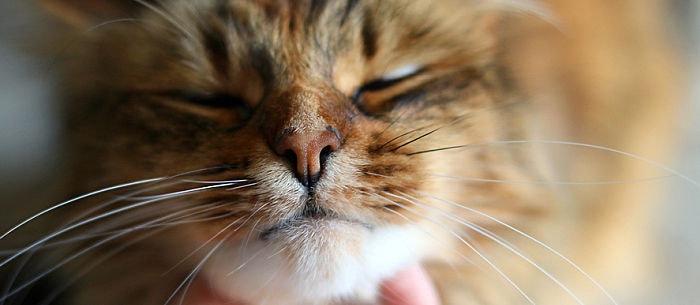Does your cat seem to have brown or black dirt around the chin that doesn’t go away? Your pet could be breaking out — but cat acne doesn’t look the same as human acne. In fact, many people commonly mistake cat acne for dirt or flea excrement and will try to wipe, brush or wash it off to no avail. Feline acne will only occur on and around the chin, starts out as blackheads and can develop into itchy, red bumps if left untreated.
Dr. Karen Becker, veterinarian and author of “Real Food for Healthy Dogs and Cats,” helps cat owners and sitters to better understand feline acne in order to effectively identify and treat it. “There are a tremendous number of sebaceous, or oil, glands in the skin of a cat’s chin that are connected to hair follicles. In the case of acne, the follicles will become clogged with sebum, or oil, which form blackheads,” says Dr. Becker.
Cat Acne Causes
Dr. Carla Webb from Banfield Pet Hospital suggests that immune system issues can sometimes cause feline acne. “When your pet’s immune system acts abnormally to allergens, like fleas or something in the diet, skin conditions can occur.” Dr. Becker agrees, and explains that many underlying conditions can cause cat acne to develop. “No one knows the exact cause of feline acne, but there seem to be several contributing factors,” she adds. Here are some of the things that can cause feline acne.
- Hyperactive Sebaceous Glands
If your cat produces an excess of sebaceous oil, all of that oil can end up clogging the hair follicles around the chin.
- Contact or Atopic Dermatitis
Chemicals in shampoos or household cleaners can irritate your cat’s skin, causing acne to develop.
- Food Hypersensitivities
Feline acne can occur as a result of an allergy to foods such as eggs, seafood, wheat, poultry and soy.
- Hormone Imbalance
Just like a teenager going through puberty, even cats can have hormonal breakouts.
- Poor Grooming Habits
Older or disabled cats sometimes have difficulty grooming themselves regularly, which can contribute to feline acne. You may have to decide if your cat needs a trip to the groomer.
- Compromised Immune Systems
Cats with autoimmune diseases or a chronic infection can develop acne as a result of weakened immune functioning.
Sometimes acne can happen as a result of less serious issues, such as rubbing things with their chins, thereby pressing oils deep into the hair follicles. If you suspect that your cat may have acne, make an appointment with your vet in order to rule out more serious conditions.
Treating Cat Acne
Sometimes cases of mild feline acne might not need treatment and will subside on their own. However, if you notice that your cat’s blackheads have transformed into red bumps or have started to cause hair loss, your cat might need treatment. If more severe acne isn’t treated, the pimples could progress into dangerous abscesses. Feline acne treatments include:
- Changing the Diet
Dr. Becker recommends reducing grains, poultry and seafood in your cat’s diet to see if the acne improves.
- Resolving Underlying Illness or Imbalances
Feline acne can subside on its own once you treat any contributing illnesses or imbalances.
- Disinfect Daily
Wash the affected area daily using a gentle organic soap that does not contain artificial dyes or perfumes. This will remove bacteria and excess oil.
- Dab With Witch Hazel
Apply a small amount of witch hazel on to your cat’s chin with a cotton swab after disinfecting. The witch hazel acts as an astringent to further remove oil and tighten pores. Proactively applying witch hazel to a cat’s chin can also help prevent breakouts in the future.
- Apply Aloe vera Gel
Using your finger, spread a small amount of aloe vera gel over the area after disinfecting. Aloe vera soothes the skin and reduces inflammation to speed up healing.
- Apply Manuka Honey
This special type of medicinal honey contains antibiotic properties that will help heal feline acne. Dab the honey on to your cat’s chin after disinfecting. You can find manuka honey at most health food stores.
- Replace Plastic Water Bowls
Sometimes the plastic or dye found in pet dishes can cause contact allergies. Try replacing your cat’s plastic water dish with one that’s metal or ceramic.
Kelly Sundstrom is an award-winning journalist, author and artist. As the caretaker of two dogs, five cats and a bearded dragon, Sundstrom understands the importance of prevention in keeping pets healthy.


